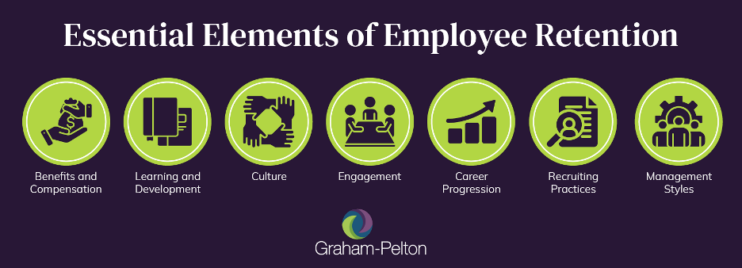5 Essential Employee Retention Tips for Nonprofit Managers

Employee retention is critical for the health of any organization, particularly for nonprofits. High retention leads to better outcomes all around as the organization saves money and develops stronger performers internally.
Plus, as a manager in a nonprofit, retention is a key component of your job. Retaining top performers is likely a measure of your effectiveness and success in your role.
Of course, many diverse factors contribute to retention or conversely, turnover, and the past several years have been rocky in this regard. The pandemic, the Great Resignation, and an overall turbulent economy have all impacted labor trends in unforeseen and even unprecedented ways.
But while not every contributing factor to retention will be within your control as a manager, many thankfully are. What are these controllable factors, and how can you build stronger practices and habits to foster increased retention?
Let’s get back to the basics with a refresh on fundamental employee retention best practices.
1. Understand the broader concept of talent strategy.
Employee retention must be understood holistically—many interconnected elements create an environment where employees feel valued and want to stick around to grow their impact.
So, rather than honing in on just a few individual practices as part of a limited-scope retention strategy, it’s ultimately more helpful to look at your organization’s broader talent strategy and how it is or isn’t helping to drive retention. In our guide to nonprofit employee retention, here’s how we describe talent strategy:
Talent strategy refers to an organization’s practices and policies for managing employees and using their contributions to drive the greatest impact… For nonprofits, talent strategy should take extra considerations into account, like mission alignment, volunteer management, and indirect compensation (non-monetary ways to support retention and engagement goals).
All of your organization’s practices directly or indirectly contribute to retention by creating a more engaging and well-run workplace. These elements are particularly important:

Alt text: The key elements and practices that contribute to nonprofit employee retention, detailed in the text below.
- Benefits and compensation (both direct and indirect)
- Learning and development opportunities
- Culture and communication styles
- Employee engagement practices
- Career progression opportunities and communication
- Recruiting practices and onboarding experiences
- Management styles and frameworks
The concept of talent strategy encourages organizations to consider the employee experience across all stages of the relationship, as well. Recruiting and onboarding may have larger impacts on your ultimate retention rate than you initially realized, for instance. After all, these first impressions set the tone for the relationship and may equip (or not equip) new hires for success and satisfaction down the line.
If you’re seeking to improve your nonprofit’s employee retention rate, start by reviewing your organization’s practices in each of the categories above and think through how they relate to retention outcomes. What are you currently doing or not doing? What problem spots do you already know about? How can you identify gaps in your current talent strategy?
2. Gather feedback and communicate openly.
To identify talent strategy gaps, go straight to the source—ask your employees. Regularly collecting employee feedback can:
- Help you identify weak spots or perceived problems with different aspects of your talent strategy.
- Source new internally- or externally-facing ideas for improvements.
- Reveal performance wins or issues that weren’t previously on your radar.
- Fine-tune new management and engagement tactics as they roll out.
- Show employees that you value their input and ideas.
The key to effectively using feedback as a retention tool is to actively do something with the information you collect. Nothing saps a team’s enthusiasm for improvement like the impression that their thoughts and ideas are being ignored.
When you receive feedback and ideas from employees, think about them and consider the right course of action. Then, discuss them with the team member. Take the time to explain why certain suggestions are or aren’t put into action.
Not only does this practice provide employees with more insight into organizational decisions, but it also leads to generally improved team alignment and decision-making. When employees understand how and why your nonprofit makes certain decisions, they become better at pushing your mission forward.
3. Give feedback and transparently discuss performance.
Your employees aren’t the only ones who should be sharing their thoughts—managers should frequently give feedback to their direct reports, and a lot of it.
Think of it this way: The state of an employee’s performance should never come as a surprise during performance reviews. Whether things are going well or need improvement, both you and the employee should know well in advance so that you can work together to either drive even greater impact or find solutions.
A lack of feedback and, by extension, a shared understanding of expectations, can be a major driver of turnover. Employees understandably become frustrated when they have no clear insight into what they’re doing right or wrong and how those actions impact the way their performance is judged. Consistently delivering feedback ensures that you’re both on the same page.
If giving feedback isn’t a strong suit of your organization’s practices and culture, do some research and practice on your own to develop better feedback habits. A statement of the specific action an employee took, the impact it had (positive or negative), and a request for a next step (either continuing the action or changing it next time around), should be plenty to give employees a crystal clear idea of how things are going.
The performance review process itself should also be straightforward and transparent. Hold them at regular times and follow a set agenda. Perhaps employees fill out a standard survey beforehand or receive your notes ahead of time so that you can both be prepared to have as productive a conversation as possible.
4. Assess your goals and incentive structures.
Effective goal-setting can be a powerful retention tactic by building feedback, development, and engagement into day-to-day work, both at the team-wide and individual levels.
If you don’t already set quarterly or annual goals for your team, consider how you might start. If you have a goal system in place, make sure to regularly revisit it. Goals need to be realistic and highly relevant to your organization’s current priorities to prevent them from inadvertently sapping motivation.
An ideal goal is ambitious to encourage growth but not so high as to feel unachievable at the organization’s or team’s current capacity or skill level. It’s also objectively measurable through concrete KPIs.
For managers of fundraising teams, there may be incentive components in play that also require regular reviews to ensure achievability and relevance. Consider these tips for motivating gift officers with goals and incentives:
- Use your data to find realistic targets. You don’t need to design perfectly tailored individual goals for every employee, but you can work to set more realistic goals by pipeline stage or portfolio maturity.
- Regularly review progress with the team. Collective progress towards a shared goal could be reviewed in each morning’s huddle, and individual progress could be covered in regular check-ins or weekly one-on-one meetings to discuss any problems or ideas that have arisen.
- Double-check that your KPIs are as relevant and useful as possible. For example, organizations might still use in-person meetings as a key metric for gift officers despite communication preferences and habits changing so dramatically post-2020. Consider your niche, as well—higher ed or healthcare fundraising programs work differently than typical charitable fundraising processes, so goals and trajectories should be designed with those distinctions in mind as needed.
This is one area where data is extremely helpful for managers. You’ll need to not only collect it to measure progress and discuss performance but also to establish benchmarks for future reference and growth. If your organization doesn’t have the systems or practices in place to do this, try making the case to leadership or start your own processes if possible.
5. Actively recognize standout contributions.
Finally, you need to intentionally recognize contributions as they occur. This is a fundamental employee engagement tactic that leads to improved performance and satisfaction, and thus retention, but it’s so easily neglected in the day-to-day work of busy nonprofits.
Employee recognition can be as simple or as elaborate as you want or as the organization allows. Small gestures can be particularly effective at assuring employees that their work is noticed and valued. These could take the form of:
- Quick shout-outs in team meetings
- More formally delivered positive feedback and messages of thanks
- Inclusion in organization-wide newsletters or bulletin boards that highlight important wins and developments
- Small spot bonuses, like gift cards or extra PTO days, scaled to the impact of the achievement
One especially effective practice is to empower your team with peer-to-peer recognition. Allow team members to casually recognize each other for their contributions and impacts. Quick emails can work, but for the best long-term impact, try using a survey or eCard system that will keep track of the shout-outs and notify you when they’re sent.
This approach gives you as a manager increased visibility into all the ways that employees are driving impact for the organization, even those that aren’t immediately visible to you. Plus, it strengthens ties between team members and fosters a more productive culture of collaboration.
To make these recommendations stick, double-check your organization’s data practices. While you likely already have processes in place for tracking donations and donor relationships, don’t forget that management should be a data-informed process, too.
A combination of qualitative feedback from employees plus performance data, quantitative survey results, and recognition records gives you a solid foundation to continually improve your talent strategy and drive retention.


